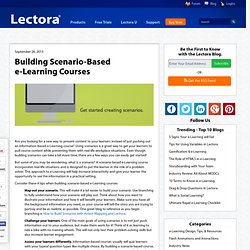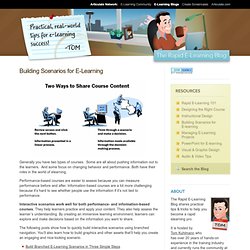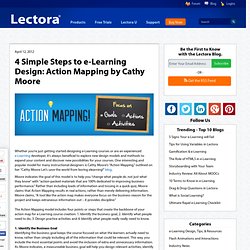

Dr. Will Thalheimer - Simulations that Work: What the Research Says... Creating the Illusion of Complexity - Simplifying Simulation Development - Webinar 12/17/2012. Dr. Will Thalheimer - Situation‐Based Learning Design. Article - The Power of Scenario-Based Questions (Resources) Article - Secrets to Writing Great Scenarios (Resources)
By Will Thalheimer, PhDOCTOBER 15, 2013 Introduction In my first article in this series, I described the research-based support for the power of scenario-based questions.

You can access that article by clicking here. Not Just Learning Objectives Typically, as instructional designers, the first thing we do after performing a training needs analysis is create a list of learning objectives. Concepts and principles, if taught without reference to the situations that connect them to real-world work situations, become isolated information in long-term memory—information that is unlikely to be recalled when it is needed. So, instead of just creating a list of learning objectives focusing on the core concepts and principles, we also need to create a list of the key workplace situations where the concepts will be utilized. In a team meeting where the team is making a joint decision without the team leader involved. Doing Needs Analysis What Should Go Into a Scenario Scene? Article - The Power of Scenario-Based Questions (Resources)
Article - Using Scenario-Based Questions as an Assessment Tool (Resources) By Will Thalheimer, PhDNOVEMBER 12, 2013 Introduction In my first article in this series, I described the research-based support for the power of scenario-based questions.

You can access that article by clicking here. In the second article, I shared tips on how to write great scenarios. You can access the second article by clicking here. Building Scenario–Based e-Learning Courses. Are you looking for a new way to present content to your learners instead of just pushing out an information-based e-Learning course?

Using scenarios is a great way to get your learners to pull course content while presenting them with real-life workplace situations. Even though building scenarios can take a bit more time, there are a few ways you can easily get started! But some of you may be wondering: what is a scenario? How to Build Scenarios with Action Mapping and Lectora. “Action Mapping is a way to design your e-Learning content and focuses on ‘doing’ not “knowing,” said Betty Hornor, presenter at the 2013 Lectora® User Conference.

It is also a great way to prevent e-Learning developers from giving their learners an information overload within their online training course. To begin to build your action map, you first should follow these four basic steps: Define your business goal Identify what learners must do to accomplish their goal Select what activities will help Pinpoint what content is really, really crucial Here is an example from Hornor’s presentation of an action map: Building Scenarios for E-Learning. Generally you have two types of courses.

Some are all about pushing information out to the learners. And some focus on changing behavior and performance. Both have their roles in the world of elearning. Scenario Based Learning. The Basics of Scenario-Based e-Learning. In this post, I will walk you through the various aspects of scenario-based eLearning, so that you can design eLearning courses which not only keep the learners motivated and engaged, but provide them with the best possible educational experience that effectively enhances their skill sets and/or knowledge base.

There are a myriad of instructional design theories and models to choose from when creating eLearning courses. In fact, selecting the one that fits your students’ or employees’ needs can often be a challenging task. How to Engage Learners with Scenario-based Learning by Hans Kövi & Kasper Spiro. “There are numerous ways to design an SBL, and how you design it depends on a number of factors.

The educational level, the learning topic, and of course the available budget are important variables. But no matter how you design scenario-based learning, you can use it for situations that include medical training, sales training, and compliance training.” The demand for scenario based-learning (SBL) is growing rapidly. SBL is now the most requested type of eLearning among our customers. This is part of the trend to use eLearning more and more for skill training and not just for knowledge transfer. In this article, we dive into the theory that explains why SBL can be effective, and we give some guidance on how to develop effective SBL. Handbook of Positive Psychology.
How to Build Scenarios with Action Mapping and Lectora. Twine / An open-source tool for telling interactive, nonlinear stories. 4 Simple Steps to e-Learning Design: Action Mapping by Cathy Moore. Whether you’re just getting started designing e-Learning courses or are an experienced e-Learning developer, it’s always beneficial to explore new design models and methods to expand your content and discover new possibilities for your courses.

One interesting and popular model for many instructional designers is Cathy Moore’s “Action Mapping,” outlined on her “Cathy Moore Let’s save the world from boring elearning!” Blog. Moore indicates the goal of this model is to help you “change what people do, not just what they know” with “action-packed materials that are 100% dedicated to improving business performance.”
Rather than including loads of information and tossing in a quick quiz, Moore claims that Action Mapping results in real actions, rather than merely delivering information. Moore claims, “A tool like the action map makes everyone focus on the business reason for the project and keeps extraneous information out – it provides discipline.” 1. 2. 3. 4.